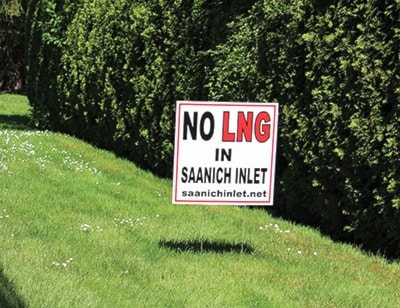The District of Central Saanich has expressed strong opposition to the proposed Malahat Liquefied Natural Gas (LNG) project being touted by company Steelhead LNG and members from the community were right behind them.
On May 9, President of Steelhead LNG Victor Ojeda gave a presentation to the municipality, with technical advisor Ian Hill and the CEO of the Malahat First Nation, Renee Racette.
Ojeda began by stating that they are very early into the process and haven’t entered the regulatory process yet. Ojeda said he saw the presentations as the beginning of a dialogue with the district and community members to further understand views and concerns.
Racette got up to say a few words and said the new council of the Malahat First Nation came into a relationship with Steelhead LNG with very little information and had to look further into it.
“We heard, to be honest a lot of scary and ... terrifying things about what would happen to the (Saanich) Inlet, to our nation, to our community, and it was alarming,” she said.
“And this council said ‘we have to pay attention, we have to get some answers,’ and so we did. And that’s what we have been working on aggressively for the last months.”
The proposed LNG plant, which will be at Bamberton, will work with the Malahat Nation and will facilitate the export of liquefied natural gas to Asia — but not at the sacrifice of safety and the environment, explained Ojeda.
Hill explained what LNG is and what it is not.
“So first of all, LNG is very simply taking natural gas, shoving it through a refrigerator and making liquid,” he said, adding it’s non-corrosive, non-explosive and not flammable.
Among the crowd of concerned residents was Deputy Leader of the B.C. Green Party, Adam Olsen, who was also raised on the Tsartlip First Nation.
Olsen expressed his strong opposition and reminded Central Saanich council that they represent Tsartlip and Tsawout First Nations. He added all four First Nations on the Saanich Peninsula expressed their opposition to the facility.
“So I just ask that you represent the First Nations that are within Central Saanich, and I would strongly recommend that you support the motion (of opposing the LNG Facility) … because I think that it reflects what the chiefs or the Saanich people have said and recognizing that there are treaty and aboriginal interests on both sides of the Inlet and this is a shared territory,” he said adding, “There is not a place worse suited for an LNG facility than this one.”
The presenters went on to show an artist rendition of the proposed project, but said they are not yet in the design phases, so it’s still subject to change.
“The concept is to create liquefied natural gas facilities on top of ... barges and have them brought in and moored up against the shoreline,” said Ojeda.
Ships would come in at roughly one ship every three to five days, he continued. They would be in the loading process for between 12 and 24 hours before sailing to market.
“It is important to note that these ships will not anchor in the Inlet … they are not sitting out waiting in the harbours and so forth,” he said.
Central Saanich Councillor, Alicia Holman asked what the safety risks were for the community and how they would be mitigated.
“In the event of a spill for example, there has never actually been a loss of containment in the history of the industry in 60 years,” said Hill.
Steelhead LNG is also proposing a pipeline from Sumas, Washington State to the facility. Hill said the pipeline is less defined and is part of future plans as they have not yet prescribed a route and are still looking at corridors and different approaches.
Holman asked how the company is going to move forward with local First Nations who are opposed to the project. Racette said the Malahat Nation and other nations do have aboriginal rights and title and treaty rights in the area, but long gone are the days that corporations can just run roughshod over First Nations.
“They have actively been training all our members for environmental assessment. They have actually been training and paying our members who go out with them every day and are participating,” she said, adding, “and they’re not allowed to go out without our members.”
Coun. Zeb King stated many people seem to believe the project is simply a bait and switch and that it will never happen.
Mayor Ryan Windsor also expressed opposition.
“I mean were talking about potential increase to net greenhouse gas emissions from Vancouver Island,” he said. “This is a community that definitely is very sensitive to a net increase of greenhouse gases.”
Windsor added like most other communities in B.C. they are signatory to the Climate Action Charter to reduce their own greenhouse gas emissions.
Residents also expressed concerns, the main ones being the possibility of explosion, negative effects to marine life and the effect on various recreational activities.
King made the motion that the District express opposition to the proposed floating LNG facility in the Saanich Inlet, along with the associated pipeline through the Salish Sea.
“I am comfortable supporting this motion this evening,” said Holman.
The only councillor not in agreement was Coun. Carl Jensen who said they shouldn’t be drawing the proposal into a municipal process at this point.
“Secondly, why are we rushing to an official stance on this issue?” Jensen asked.
“In the interest of fairness and equity, we should allow Steelhead LNG and the Malahat First Nation to complete the full review process.”
King said every time he votes, he votes with the information he has at that point and remains in opposition.
The motion was passed, but must still be ratified at a regular council meeting.
